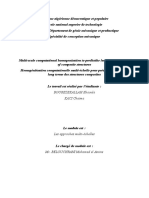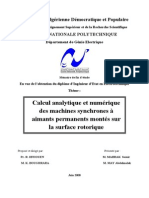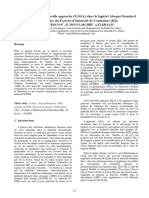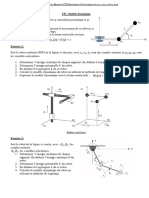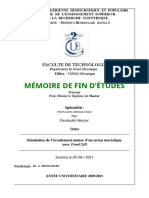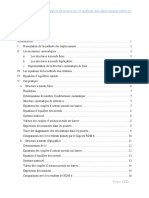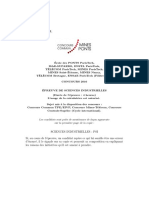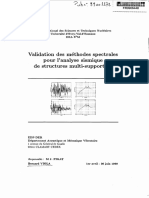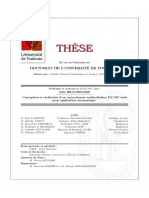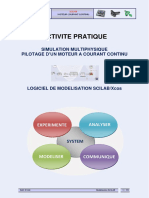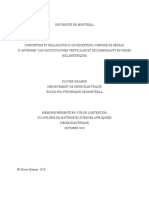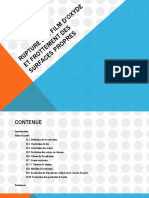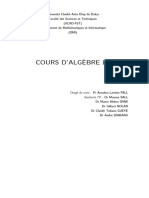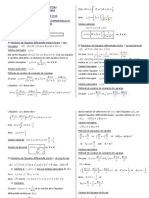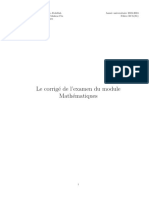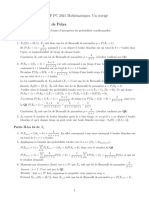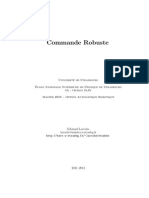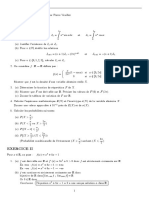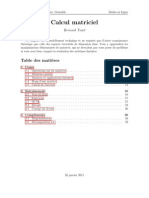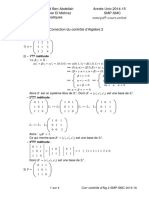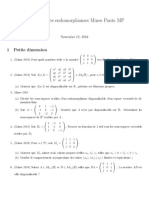Bousbia Leila
Bousbia Leila
Transféré par
Djedili AmelDroits d'auteur :
Formats disponibles
Bousbia Leila
Bousbia Leila
Transféré par
Djedili AmelTitre original
Copyright
Formats disponibles
Partager ce document
Partager ou intégrer le document
Avez-vous trouvé ce document utile ?
Ce contenu est-il inapproprié ?
Droits d'auteur :
Formats disponibles
Bousbia Leila
Bousbia Leila
Transféré par
Djedili AmelDroits d'auteur :
Formats disponibles
IMMAT’2022
2nd Edition of the international conference on innovative
materials, manufacturing, and advanced technologies
October 27-29, 2022 -- Sousse - Tunisia
Inverse Kinematics of Conical-Shaped Continuum Robots Based on
the Closed-Loop Algorithm
Leila Bousbiaa, Ammar Amouria, Abdelhakim Cherfiaa
a
Laboratory of Mechanics, Department of Mechanical Engineering, Frères Mentouri University
(UFMC1) , Road of Ain El Bey Constantine 25000, Algeria, leilabsb3@gmail.com,
ammar_amouri@yahoo.fr, cherfia_abdelhakim@yahoo.fr
Résumé – Jusqu’à présent, la résolution du modèle géométrique inverse IK pour des robots
continuums reste un défi en raison de sa complexité, de sa flexibilité et de son hyper-redondance.
Notre article présent une solution du modèle géométrique inverse d’un robot continuum à forme
conique appelé CSCR basé sur l’algorithme géométrique inverse en boucle fermée CLIK au niveau
de vitesse. Initialement, en se basant sur l’hypothèse de courbure constante CCKA, le modèle
géométrique direct FKM d’un CSCR à courbure variable a été développé. Les variables
apparaissant lors du calcul du modèle géométrique direct FKM du CSCR ont été réduits à l’aide
d’une méthode de réduction des variables. Ensuite, La matrice jacobienne a été présentée en
utilisant le modèle géométrique développé. Le modèle cinématique inverse a été obtenue en
utilisant le jacobienne pseudo-inverse. Par la suite, le modèle géométrique inverse IKM a été
résolu au niveau de vitesse en utilisant l’algorithme géométrique inverse en boucle fermé. Un
exemple de simulation sous logiciel Matlab a été réalisé afin de vérifier l’efficacité de la solution
proposé. D’après les résultats obtenus, la solution du modèle géométrique inverse IK proposé
pourrait résoudre avec précision le modèle géométrique inverse d’un robot continuum à courbure
variable.
Mots clés: robot continuum à forme conique / l’hypothèse de courbure constante /courbure
variable / modèle géométrique inverse / l’algorithme à boucle fermé.
Abstract – So far, solving inverse kinematics (IK) problems for Continuum Robots (CSCRs)
remains a challenge due to their complexity, flexibility, and hyper-redundancy. Our paper presents
the inverse kinematic IK solution of a conical shaped continuum robot, so-called CSCR, based on
the Closed‐Loop Inverse Kinematic CLIK algorithm at the velocity level. Initially, based on the
constant curvature kinematic assumption CCKA, the forward kinematic model FKM of a variable
curvature CSCR has been developed. The variables appear when the calculating of the FKM has
been narrowed down using a reduced variable method. Then, the Jacobian matrix has been
presented through the use of the proposed FKM. The pseudo-inverse method has been used in
order to invert the velocity kinematic. Subsequently, the IK has been solved at the velocity level
via the Closed‐Loop Inverse Kinematic (CLIK) algorithm. A simulation example through Matlab
software has been carried out to verify the efficiency of the proposed solution. Through the
obtained results, the proposed IK solution could accurately solve the IKM of a variable curvature
continuum robot.
Key words: conical shaped continuum robot / constant curvature assumption / variable curvature /
inverse kinematic problem / the closed-loop algorithm.
27-29 Octobre, Sousse - Tunisia
2nd Edition of the international conference on innovative materials, manufacturing, and Advanced technologies IMMAT’2022
1 Introduction on the proposed forward kinematic model in [11].
This approach is used to narrow down the variable
In the last two decades, the robotic field has seen a numbers to simplify the inverse kinematic problem
great evolution. Researchers are inspired by biology IKM resolution. Our main contribution in this paper
to create a continuous and soft architecture able to is to develop the IKM using the Closed-Loop
adapt to various environments. These robots are Inverse Kinematic CLIK Algorithm at the velocity
named continuum robots. Because of their high level. The velocity kinematic describes the robot tip
flexibility, dexterity, and hyper-redundancy, velocity according to the configuration space
continuum robots are used in a wide range of velocity using the Jacobian matrix. Inversely, we
applications, including surgery [7], space inspection aim to describe the configuration space velocity
[8], aero-engine repair and inspection [12], according to the robot tip velocity using the
agriculture [3], and so on. However, these features Jacobian pseudo-inverse [17]. Based on the
make continuum robot modeling a challenge due to weighted least norm method [6], the closed loop
its complexity. algorithm has been used to obtain the inverse
Solving inverse kinematic problems is one of the kinematic model.
difficult issues in continuum robot modeling. The This paper is organized as follows: Section 2
hyper-redundancy derives from an infinite number presents the continuum robot, namely the CSCR
of IK solutions. Several methods and approaches description. Section 3 presents the forward
are proposed to solve the IK problem. In [14, 6], kinematic model. The inverse kinematic has been
analytical methods based on mathematical solved in section 4. A simulation example has been
equations have been used. In [6], the inverse implemented and the results have been discussed in
kinematic has been developed for a single-section section 5. Finally, section 6 concludes the paper and
continuum robot. The authors assumed that the gives some prospects.
robot section is inextensible and curves as a perfect
circular arc in which the constant curvature 2 Description of the conical shaped
assumption is used. The numerical methods are also continuum robot
used to solve the IK model. In [9], the Newton-
Raphason iterative method and the least square In this section, a kinematic description of a cable-
method have been used to develop the IK. The driven conical-shaped continuum robot, namely
metaheuristic optimization method has been used to CSCR, is presented. Figure 1 presents a CAD view
solve the IK in several works due to its efficiency of the considered continuum robot. As illustrated in
[1-2, 13]. Researchers in [2] developed the IK using this figure, the CSCR is composed of one single
practical swarm optimization and the genetic section; in three-dimensional space, the proposed
algorithm, in which a comparison between the two CSCR has 2 DOF, an orientation angle, and a
methods indicates that the practical swarm bending angle, noting that the torsion effect has
optimization PSO is more accurate than the genetic been ignored. The CSCR is composed of a flexible
algorithm. Learning-based approaches have also rod divided into five units by six rigid disks, where
been used to better predict the continuum robot the lower disk and the upper disk are made of 30
behavior. A learning method based on the neural mm and 20 mm in diameter respectively, in which
network has been proposed in [18]. The main idea the first disk is considered as a fixed base. Each
is to learn a global-specific IK solution for the unit is made of 60 mm. Each disk has three guiding
redundant robot. In the same context, researchers in holes spaced at 120°. Three actuated cables are
[10] used a learning approach based on the growing passed through the guiding holes along the CSCR.
neural gas to solve the IK for wheeled mobile Each unit is assumed to curve as a perfect circular
continuum manipulators WMCM. Another method arc in which each section could be curved as a
to solve the IK is based on the differential inverse variable curvature. The used nomenclature is
kinematic model. Researchers in [4] developed the presented in Figure 2. It should be noted that the
IK using the differential inverse kinematic in which index i refers to the cable number and the
the Jacobian matrix has been calculated based on index j refers to the unit’s number
the modified Denavit-Hertemberg method. Using
the same method, in [16] the Jacobian matrix is where i 1,..,3 and j 1,..,5 .
calculated based on the constant curvature
assumption. To solve the differential inverse
kinematic, the pseudo inverse method has been
used. Finally, the IK has been solved using
kinematic control.
In this paper, we focus on the conical-shaped
continuum robot, namely CSCR. The forward
kinematic model FKM of a driven cable conical
shaped continuum robot has been developed based
Sousse 27-29 Octobre 2022, Tunisie 1
The international conference on innovative materials, manufacturing, and advanced technologies IMMAT’2019
c 2 c j s 2 cc js cs cs j
j1
R j cc js cs s 2 c j c 2 ss j
cs j ss j c j
(2)
lj
c j (1 c j )
j
l
j
r jj1 s j (1 c j )
j
lj
Figure 1. A CAD view of the CSCR in three- s j
dimensional space j
The specific mapping gives the arc parameters as a
function of the cable length. However, for a conical
shape unit, this mapping does not provide an
analytical solution. Thus, considering the
orientation angle equal to zero (i.e. 0 ), the
proposed approach in [11] based on the
optimization method is used to describe the bending
angle 1 according to the first cable length
variation 1,1 by the following equation:
1 2.0755.10 ˆ 1,1
3
1.0626.102 ˆ 1,1
4 2
2.4401ˆ 1,1
5.2612.104
Figure 2. The nomenclture of the CSCR unit
The forward kinematic of the conical shaped
3 Forward kinematic model of the continuum robot composed of one section is given
as follow:
CSCR
m
H 0m H jj1
Among the forward kinematic modeling methods,
the constant curvature kinematic assumption j 0
(CCKA) is known as a characteristic of the
continuum robots due to its simplicity. Based on the For each unit, the bending angle is obtained using
(CCKA), the CSCR is composed of a finite number the same method according to the first cable length
of units serially attached; each unit curves as a variation. However, in order to reduce the number
circular arc, having individual arc parameters. This of variables, the angle j where ( j 2,..,5) is
yields a unit kinematics with a piecewise constant expressed as a function of the first bending angle
curvature, providing the ability to be fitted to the
1 as follows:
CSCR curves of variable curvature.
The forward kinematic model of the j unit could be
decomposed into two mapping. An independent j c1, j13 c2, j12 c3, j1 c4, j
mapping describes the task space (X j , Yj , Z j )
Where table 2 presents the forward kinematic
according to the configuration space ( j , rj , j ) this
model coefficients c1, j , c2, j , c3, j and c4, j
mapping could be giving by the homogeneous
transformation matrix as follows: Table2. Forward kinematic model coefficient
j 2,..,5 c1, j c2, j c3, j c4, j
j1
R j1 r jj1
H j j
013 1 2 3.052. -3.608. 1.0908 1.097.
10-6 10-4 10-4
Noted that R jj1 and
r jj1 are respectively the 3 7.914. -9.088. 1.1997 3.371.
10-6 10-4 10-4
rotational matrix and the position vector. They are 4 1.586. -1.759. 1.3326 8.113.
expressed as follows: 10-5 10-3 10-4
Monastir 16-18 Octobre, Tunisie 2
2nd Edition of the international conference on innovative materials, manufacturing, and Advanced technologies IMMAT’2022
5 2.935. -3.115. 1.4984 1.829. 4.2 The Closed‐Loop Inverse Kinematic
10-5 10-3 10-3 Algorithm CLIK
4 Forward kinematic model of the
CSCR
By definition, the Inverse Kinematic Model (IKM)
describes the actuation state according to the robot
tip configuration. This paper aims to identify the
arc parameters according to the desired trajectory of
the CSCR using the Closed‐Loop Inverse
Kinematic (CLIK) Algorithm at the velocity level. Figure 3. The closed-loop inverse kinematic CLIK
For a desired trajectory from the robot algorithm
workspace X d (t) , the arc parameters should be
defined, including the initial condition to achieve As presented in figure 3, the Closed‐Loop Inverse
the desired trajectory. Kinematic (CLIK) Algorithm is defined as
follows: at the velocity level, for a desired
4.1 The velocity kinematics trajectory X d (t) we obtain the corresponding space
configuration velocity Qk (t) . Using the weighed
The velocity kinematics is obtained by
least-norm solution proposed in [17], the
differentiating the forward kinematic model FKM
configuration space velocity is given as:
with respect to time. Focusing on the independent
transformation, the velocity kinematic model could
be given as follows: Qk W 1J T (JW 1J T )1 (X d K( X d X g ))
X J(Qk )Qk And (k 1, 2)
Noted that Q k is the arc parameter, Qk is the 5 Results of simulation
vector of the bending j and the orientation In order to underline the accuracy of the closed-
velocity, X is the CSCR tip velocity and J(Qk ) is loop inverse kinematic algorithm, a simulation of a
driven cable conical shaped continuum robot has
(p q) the dimensional Jacobian matrix. This been performed in Matlab software using Intel Core
matrix is a function of the bending angles and the i5, 2.60 GHz, 8 Go RAM, 64-bit operating system.
orientation angle. This matrix could be calculated As presented in figure 4, the proposed method is
analytically by differentiation with respect to the used for a tracking trajectory in the planar
bending and the orientation angles of the position projection within a single section CSCR’s
vector of the CSCR obtained previously as workspace.
follows:
rj0 rj0 rj0
J(Qk )
Qk j
Using the proposed FKM, the Jacobian Matrix
could be calculated as:
rj0 rj0
J(Qk )
1
In this case of p q , the velocity kinematic is
inverted via the pseudo-inverse method. The Figure 4. The desired trajectory within the CSCR’s
banding and the orientation velocity could be workspace
calculated by the following equation:
Some configuration of the driven cable CSCR a
Qk JT (JJT )1 Xd tracking the desired trajectory are presented in
figure 5, as presented the generated trajectory is
very close to the desired trajectory. The Euclidian
Sousse 27-29 Octobre 2022, Tunisie 3
The international conference on innovative materials, manufacturing, and advanced technologies IMMAT’2019
error presented in the figure 6 shows that the figure 8. As presented in figure 8, the curves are
maximum error is less than 0.1 mm. very close. The Euclidian error presented in figure
8 a significant convergence between the two curves
is seen where the maximum error is less than
2.104 .
Figure 8. comparison and error analysis between
the obtained benting angle from the CLIK agorithm
and the IKM
As well as a comparison between the orientation
angle corresponding to the desired trajectory and
Figure 5. Some configuration of the CSCR a obtaned using the CLIK and the obtained using the
tracking the desired trajectory FKM is presented in figure 9.as presented in figure
9, the maximum error is less than 6.103 .
Figure 9. comparison and error analysis between
the obtained orientation angle from the CLIK
Figure 6. The Euclidian error analysis of the agorithm and the IKM
CSCR trajectory
To derive the IKM, it is necessary to obtaine the
The variation of the obtained bending angles usig cable length variation. The variation of each cable
the CLIK algorithm is presented in figure 7. As length for each unit is presented in the figure 10. As
presented the bending angles value increase from shown in this figure for each cable the length
the bottom to the top of section. increase from the bottom unit to the top unit. We
can deduce that there is a proportienelle relation
between the bending angles and the cable length
variation.
Figure 7. The bending angle variation
In order to verify the efficiency of the closed-loop
inverse kinematic algithm, a comparison between Figure 10. variation of the cables length
the first bending angle 1 obtained using the CLIK
algorithm and the corresponding bending angle to 6 Conclusion
the desired trajectory using the FKM is presented in
Monastir 16-18 Octobre, Tunisie 4
2nd Edition of the international conference on innovative materials, manufacturing, and Advanced technologies IMMAT’2022
In this paper, based on some hypothesis, the EMBS I nternational Conference on
forward kinematic model of a variable curvature Biomedical Robotics and Biomechatronics,
continuum robot, namely CSCR, is presented using 690-695, 2006.
a reduced variable method. This method aims to [9] I. Singh, O. Lakhal, Y. Amara, V. Coelen,
reduce the number of variables appear when the P.M. Pathak, R. Merzouki, Performances
calculating the CSCR's FKM. Based on the evaluation of inverse kinematic models of a
developed FKM, the IKM is solved using the compact bionic handling assistant,
Closed-Loop Inverse Kinematic algorithm at the International Conference on Robotics and
velocity level. Initially, the Jacobian pseudo-inverse Biomimetics (ROBIO), 264-269, 2017.
is used to develop the inverse velocity kinematic. [10] G.S. Chirikjian. Hyper-redundant manipulator
Secondly, the bending and the orientation velocity dynamics: A continuum approximation,
are calculated based on the weighted least-norm Advanced Robotics, 217-243, 1994.
solution. Finally, the CLIK algorithm is used to [11] L. Bousbia, A. Amouri, A. Cherfia. Forward
solve the IKM. In order to verify the proposed kinematics and workspace analysis of a single
method's accuracy, a simulation of a single-section section conical-shaped continuum robot’’, 3rd
CSCR composed of 5 units is implemented in International Conference on Mechanical
Matlab software. According to the obtained results, Sciences, 631-640, 2021.
this method is not computationally expensive as [12] M. Wang, X. Dong, W. Ba, A. Mohammed, D.
long as the proposed method achieves good Axinte, A. Norton. Design, modeling and
performance. As a perspective, we intend to extend validation of a novel extra slender continuum
the CLIK algorithm for a multi-section continuum robot for in-situ inspection and repair in aero-
robot to track a different trajectory. engine, Robotics and Computer-Integrated
Manufacturing, 102054, 2021.
References [13] S. Djeffal, A. Amouri, C. Mahfoudi.
Kinematics modeling and simulation analysis
[1] A. Amouri, C. Mahfoudi, A. Zaatri. of Variable Curvature Kinematics Continuum
Contribution to inverse kinematic modeling of Robots, UPB Scientific Bulletin, Series D:
a planar continuum robot using a particle Mechanical Engineering, 27–42, 2021.
swarm optimization, Conference on [14] S. Neppalli, M.A. Csencsits, B.A. Jones, I.D.
Multiphysics Modelling and Simulation for Walker, Closed-form inverse kinematics for
Systems Design, 141-150, 2014. continuum manipulators, Advanced
[2] A. Amouri, C. Mahfoudi, A. Zaatri, O. Lakhal, Robotics, 2077-2091, 2009.
R. marzouki. A metaheuristic approach to solve [15] T. Maahs, V. Saadat, C. Rothe, T. Le.
inverse kinematics of continuum manipulators, Disposable shapelocking system, U.S. Patent
Proceedings of the Institution of Mechanical Application, 238-298, 2006.
Engineers, Part I: Journal of Systems and [16] T. Mahl, A. Hildebrandt, O. Sawodny. A
Control Engineering, 380-394, 2017. variable curvature continuum kinematics for
[3] A. Yeshmukhametov, K. Koganezawa, Y. kinematic control of the bionic handling
Yamamoto. Novel discrete wire-driven assistant, transactions on robotics, 935-949,
continuum robot arm with passive sliding disc: 2014.
Design, kinematics and passive tension control, [17] T.F. Chan, R. Dubey. A weighted least-norm
Robotics, 51, 2019. solution based scheme for avoiding joint limits
[4] B.A. Jones, I.D. Walker. Kinematics for for redundant joint manipulators, IEEE
multisection continuum robots, Transactions on Transactions on Robotics and Automation,
Robotics, 43-55, 2006. 286–292, 1995.
[5] B. Siciliano, L. Sciavicco, L. Villani, G. [18] T.G. Thuruthel, E. Falotico, M. Cianchetti, C.
Oriolo. Robotics: Modeling Planning and Laschi. Learning global inverse kinematics
Control, 2009. solutions for a continuum robot, Symposium
[6] C. Escande, R. Merzouki, P.M. Pathak, V. on robot design, dynamics and control, 47-54,
Coelen, Geometric modeling of multi-section 2016.
bionic manipulator, Experimental validation on
robotinoxt International Conference on
Robotics and Biomimetics, 2006-2011, 2012.
[7] D. Kundrat, A. Schoob, L. A. Kahrs, T.
Ortmaier. Flexible robot for laser
phonomicrosurgery, Soft Robotics, 265-271,
2015.
[8] J. S. Mehling, M. A. Diftler, M. Chu, M.
Valvo. A minimally invasive tendril robot for
in-space inspection, The First IEEE/RAS-
Sousse 27-29 Octobre 2022, Tunisie 5
Vous aimerez peut-être aussi
- 21 SCIPCJ1ME2 SantorinDocument28 pages21 SCIPCJ1ME2 SantorinLETUDIANTPas encore d'évaluation
- Travail Demandé (Enregistré Automatiquement)Document17 pagesTravail Demandé (Enregistré Automatiquement)Chaima KcPas encore d'évaluation
- Conclusion GénéraleDocument2 pagesConclusion GénéraleAbdallah JaballahPas encore d'évaluation
- 103 A18 Fouad Menasria BiskraDocument7 pages103 A18 Fouad Menasria Biskrahana tiPas encore d'évaluation
- These A ETIEVANT Maxime 2021Document153 pagesThese A ETIEVANT Maxime 2021mezianePas encore d'évaluation
- RUGC17 - Article2 - Libasse SOWDocument5 pagesRUGC17 - Article2 - Libasse SOWFlorent HounkponouPas encore d'évaluation
- Baccalaur at G N Ral 2022 Sciences de L Ing Nieur 114248 0Document30 pagesBaccalaur at G N Ral 2022 Sciences de L Ing Nieur 114248 0GayraudPas encore d'évaluation
- Asymptotical estimates for some algorithms for data and image processing : a study of the Sinkhorn algorithm and a numerical analysis of total variation minimizationDocument175 pagesAsymptotical estimates for some algorithms for data and image processing : a study of the Sinkhorn algorithm and a numerical analysis of total variation minimizationmymnaka82125Pas encore d'évaluation
- TH2014 Morand JulienDocument195 pagesTH2014 Morand Julienpapa babacar DiagnePas encore d'évaluation
- Calcul Analytique Et Numérique Des Machines Synchrones À Aim - 2 PDFDocument101 pagesCalcul Analytique Et Numérique Des Machines Synchrones À Aim - 2 PDFsambarirou100% (3)
- LE GUYADEC 2018 Diffusion PDFDocument167 pagesLE GUYADEC 2018 Diffusion PDFdernotPas encore d'évaluation
- Comm 4Document6 pagesComm 4Said EL FakkoussiPas encore d'évaluation
- 32588Document318 pages32588fabiensigmabPas encore d'évaluation
- Ghorab OlgaDocument136 pagesGhorab OlgaagabuskasepaPas encore d'évaluation
- TD Trains EpiDocument11 pagesTD Trains Epimax abolePas encore d'évaluation
- tp1 ComsolDocument7 pagestp1 ComsoldadiPas encore d'évaluation
- BF03000725Document7 pagesBF03000725Hüseyin Nuri GülmezPas encore d'évaluation
- DELIMATELES 2023 ArchivageDocument211 pagesDELIMATELES 2023 ArchivageRobio GaminGPas encore d'évaluation
- MemristorDocument18 pagesMemristormaliani adolphPas encore d'évaluation
- Si Et Al - 2023Document26 pagesSi Et Al - 2023wujh0730Pas encore d'évaluation
- Rapport Projet Mécanique Des Structures Mouncef_ASRYDocument14 pagesRapport Projet Mécanique Des Structures Mouncef_ASRYMouncef AsryPas encore d'évaluation
- Commande Adaptative D'un Robot Manipulateur FlexibleDocument94 pagesCommande Adaptative D'un Robot Manipulateur FlexiblekhaledPas encore d'évaluation
- Inondation4 PDFDocument113 pagesInondation4 PDFJacquesPas encore d'évaluation
- Cours Algèbre 3 (Chapitre 1 & 2)Document35 pagesCours Algèbre 3 (Chapitre 1 & 2)yassirclime100% (1)
- TD - Modèle DynamiqueDocument1 pageTD - Modèle Dynamiquehocine benmaiza100% (1)
- Détermination des facteurs d'intensité de contraintes KI, KII des essais de fissuration en dynamique du matériau composite verre/époxy, unidirectionnel, des éprouvettes de type CLS (Cracked Lap Shear) par la technique de Corrélation d'image et la modélisation d'Elément Finis.Document6 pagesDétermination des facteurs d'intensité de contraintes KI, KII des essais de fissuration en dynamique du matériau composite verre/époxy, unidirectionnel, des éprouvettes de type CLS (Cracked Lap Shear) par la technique de Corrélation d'image et la modélisation d'Elément Finis.Zahi DrawPas encore d'évaluation
- 1995TH Maleki K NS19171Document366 pages1995TH Maleki K NS19171sebouppppPas encore d'évaluation
- 12770629Document180 pages12770629shahidoxxPas encore d'évaluation
- Curve Fitting Analysis of Expulsion Fuse Links Through The Cross-Validation TechniqueDocument5 pagesCurve Fitting Analysis of Expulsion Fuse Links Through The Cross-Validation TechniqueJorge Luis MarechalPas encore d'évaluation
- Introduction MSD V Octobre 2020Document5 pagesIntroduction MSD V Octobre 2020AmiNEPas encore d'évaluation
- Corr 03Document54 pagesCorr 03merida97Pas encore d'évaluation
- Element FinisDocument105 pagesElement FinisWarda JoryPas encore d'évaluation
- TATSAMBON - Méthode Des DéplacementsDocument22 pagesTATSAMBON - Méthode Des Déplacementslando de chancePas encore d'évaluation
- Conception Et Commande Vectorielle D'une Machine Synchrone À Aimants Permanents2 - CompressedDocument76 pagesConception Et Commande Vectorielle D'une Machine Synchrone À Aimants Permanents2 - CompressedOussema AntriPas encore d'évaluation
- Djerafa YasserDocument90 pagesDjerafa Yasseraibeche.rania2000Pas encore d'évaluation
- These GhanemDocument213 pagesThese GhanemaminePas encore d'évaluation
- Famh Gdrmacs2009Document6 pagesFamh Gdrmacs2009Mustapha El MouinePas encore d'évaluation
- INFOQCh2 MesureetOperateurs PDFDocument69 pagesINFOQCh2 MesureetOperateurs PDFALI DOCTAR MASSIBOU100% (1)
- Thèse OUALI AssiaDocument132 pagesThèse OUALI AssiaAbdou SebtiPas encore d'évaluation
- Approche Variationnelle Pour La Méthode Des Éléments Finis PDFDocument13 pagesApproche Variationnelle Pour La Méthode Des Éléments Finis PDFKhalloukiElMahdiPas encore d'évaluation
- Contribution Lam Odl Is at I On Des Robots ContinuumDocument152 pagesContribution Lam Odl Is at I On Des Robots ContinuumDjedili AmelPas encore d'évaluation
- Synchronous Machine Modeling Precision and Efficiency in Electromagnetic TransientsDocument171 pagesSynchronous Machine Modeling Precision and Efficiency in Electromagnetic TransientsAlex SanchezPas encore d'évaluation
- SNLDocument23 pagesSNLEL MEHDI HABBARPas encore d'évaluation
- Thèse ToulouseDocument246 pagesThèse ToulouseKarima Ait BeroualPas encore d'évaluation
- Kibboua 2011 AFPS-01Document10 pagesKibboua 2011 AFPS-01Noufal MajdiPas encore d'évaluation
- CCMP PSI 2016 MicromanipulateurCompact SujetDocument28 pagesCCMP PSI 2016 MicromanipulateurCompact SujetMartin MaurerPas encore d'évaluation
- Mode Spectrale Et Analyse SismiqueDocument63 pagesMode Spectrale Et Analyse SismiqueZakaria IdrissiPas encore d'évaluation
- Simulation Numérique de L'écoulement Autour D'une Éolienne À Axe HorizontalDocument13 pagesSimulation Numérique de L'écoulement Autour D'une Éolienne À Axe HorizontalSel MaPas encore d'évaluation
- 04 Pont Endommagement Modele NumeriqueDocument35 pages04 Pont Endommagement Modele NumeriqueFouad KehilaPas encore d'évaluation
- tolouseDC PDFDocument207 pagestolouseDC PDFIbtissem MsPas encore d'évaluation
- Activité I2D 2020 Scilab - Moteur - CCDocument9 pagesActivité I2D 2020 Scilab - Moteur - CCAeroEaglePas encore d'évaluation
- Conclusion GéneraleDocument2 pagesConclusion Géneraleمفتاح الدينPas encore d'évaluation
- 9-Chapitre IX ModélisationDocument25 pages9-Chapitre IX Modélisationf5xsbdyy9sPas encore d'évaluation
- Jerome LandureDocument85 pagesJerome LandurewatsopPas encore d'évaluation
- Algebre Lineaire 1Document81 pagesAlgebre Lineaire 1Nina Bordo100% (1)
- 2010 OlivierKramerDocument105 pages2010 OlivierKramerWach AsPas encore d'évaluation
- Flux optique: Explorer les modèles visuels dynamiques en vision par ordinateurD'EverandFlux optique: Explorer les modèles visuels dynamiques en vision par ordinateurPas encore d'évaluation
- Traité d'économétrie financière: Modélisation financièreD'EverandTraité d'économétrie financière: Modélisation financièrePas encore d'évaluation
- Reconstruction tridimensionnelle multi-vues: Techniques avancées de perception spatiale en vision par ordinateurD'EverandReconstruction tridimensionnelle multi-vues: Techniques avancées de perception spatiale en vision par ordinateurPas encore d'évaluation
- TD 02-Sei 2022Document2 pagesTD 02-Sei 2022Djedili AmelPas encore d'évaluation
- Interrogation de Mécanique RationnelleDocument1 pageInterrogation de Mécanique RationnelleDjedili AmelPas encore d'évaluation
- L3 Énergétique RattrapageDocument1 pageL3 Énergétique RattrapageDjedili AmelPas encore d'évaluation
- Mecanique Rationellesérie TD 03Document2 pagesMecanique Rationellesérie TD 03Djedili AmelPas encore d'évaluation
- Rupture Des Film D'oxyde Et Frottement Des SurfacesDocument15 pagesRupture Des Film D'oxyde Et Frottement Des SurfacesDjedili AmelPas encore d'évaluation
- TP4 ScilabDocument8 pagesTP4 ScilabYőñêšê BouhdasPas encore d'évaluation
- 10-Valeurs Et Vecteurs Propres+diagonalisation - GIDocument6 pages10-Valeurs Et Vecteurs Propres+diagonalisation - GIAnouar Belabbes50% (2)
- Corrige Maths Bce Edhec 2020Document8 pagesCorrige Maths Bce Edhec 2020Diomande WilfriedPas encore d'évaluation
- Espaces Préhilbertiens RéelsDocument13 pagesEspaces Préhilbertiens RéelsESSANY MOHAMMEDPas encore d'évaluation
- Reduction Cours de MR FallDocument66 pagesReduction Cours de MR FallThierno Mamadou Aliou DIALLOPas encore d'évaluation
- Corrigé (TD Equations Diff. Bouaké - 2016) - 1-1Document21 pagesCorrigé (TD Equations Diff. Bouaké - 2016) - 1-1Camilla Mareva100% (1)
- Ext CNC 2016Document3 pagesExt CNC 2016rimelfadil8Pas encore d'évaluation
- MatricesDocument2 pagesMatricesParrot AudreyPas encore d'évaluation
- Fic 00055Document20 pagesFic 00055ham.karimPas encore d'évaluation
- Ts Examen Ensi 2014-2015Document2 pagesTs Examen Ensi 2014-2015leonscovischPas encore d'évaluation
- Correction Examen BCGDocument7 pagesCorrection Examen BCGkabir12358fPas encore d'évaluation
- CCP2021 CorrigeDocument7 pagesCCP2021 CorrigeclouclourouPas encore d'évaluation
- Concours National Commun - Session 2000 - Mp: A: Quelques Propri´ Et´ EsdeφDocument8 pagesConcours National Commun - Session 2000 - Mp: A: Quelques Propri´ Et´ EsdeφFayCal ElabbassiPas encore d'évaluation
- Commande RobusteDocument66 pagesCommande RobusteRabiiAzdoud100% (2)
- DM 1 CalculDiff EDO 202324Document2 pagesDM 1 CalculDiff EDO 202324Tim VaceletPas encore d'évaluation
- Correction PRB 3Document7 pagesCorrection PRB 3marwaneeeePas encore d'évaluation
- Corr Endomorph K (X)Document6 pagesCorr Endomorph K (X)Mido BlmPas encore d'évaluation
- Algebre 2 by Sc-CoursDocument61 pagesAlgebre 2 by Sc-Coursjacobdembele6Pas encore d'évaluation
- CNC Maths 2 MP 2022: Structure de HDocument11 pagesCNC Maths 2 MP 2022: Structure de HAmine Lahlal100% (1)
- Calcul Matriciel: Table Des MatièresDocument35 pagesCalcul Matriciel: Table Des MatièresSafa El AmriPas encore d'évaluation
- Maths L3 CoursDocument12 pagesMaths L3 CourshenryPas encore d'évaluation
- Cor Exam 1 Algèbre s22Document4 pagesCor Exam 1 Algèbre s22azzdiebenchigrePas encore d'évaluation
- Support de Cours Algèbre 3 SMIADocument78 pagesSupport de Cours Algèbre 3 SMIAHAMZA ELYAAKOUBIPas encore d'évaluation
- Série 1Document2 pagesSérie 1Découvrir votre mondePas encore d'évaluation
- Réduction Des Endomorphismes - Diagonalisabilité Et Endomorphisme InduitDocument2 pagesRéduction Des Endomorphismes - Diagonalisabilité Et Endomorphisme InduitHamza PrintoOsPas encore d'évaluation
- Algèbre 2 PolycopiéDocument44 pagesAlgèbre 2 PolycopiéMOHAMMED ZAKARIA BAALIPas encore d'évaluation
- Correction Exam Rattrapage SVI 19 20Document7 pagesCorrection Exam Rattrapage SVI 19 20Safae HaniPas encore d'évaluation
- CM 3 MathsDocument20 pagesCM 3 MathsMarie Françoise Hernan BarryPas encore d'évaluation
- TD 1 Espaces Euclid IensDocument6 pagesTD 1 Espaces Euclid Iensqkdjzlzkja100% (2)
- reduction_exercices_psi_2024Document9 pagesreduction_exercices_psi_2024ilyesfares49Pas encore d'évaluation

